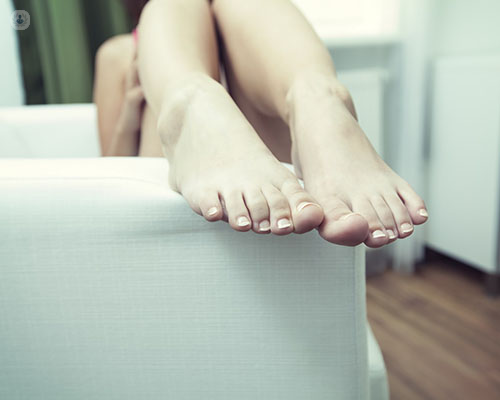What to do if you have foot pain
Autore:When it comes to foot pain, it is important to know which area of the foot hurts specifically. We’ve asked one of our top orthopaedic surgeons Mr Jordi Sanchez-Ballester for advice on what to do with each area of the foot that may be in pain from an injury, overuse or other conditions that are causing inflammation.

How can I relieve foot pain?
The following are tips on how you can ease pain in different parts of the foot at home by yourself:
Ankle
- The initial advice would be, rest and raise your ankle when you can. Put an ice pack (or bag of frozen peas) in a towel on your ankle for up to 20 minutes every 2 to 3 hours.
- Wear wide comfortable shoes with a low heel and soft sole.
- Use elastic support around your ankle to support it.
- Try regular gentle stretching exercises.
- Take paracetamol.
- Avoid ibuprofen for the first 48 hours after an injury.
- Avoid walking or standing for long periods and do not wear high heels or tight pointy shoes.
Toes (Big toe and lesser toes)
- Rest and raise your ankle when you can, put an ice pack (or bag of frozen peas) in a towel on your ankle for up to 20 minutes every 2 to 3 hours.
- Wear wide comfortable shoes with a low heel and soft sole.
- Buddy strap a painful toe by putting a small piece of cotton wool or gauze between your sore toe and the next toe. Use tape to loosely strap it up (do not do this for a big toe or a badly broken toe!).
- Take paracetamol.
- Avoid ibuprofen for the first 48 hours after an injury.
- Avoid walking or standing for long periods and do not wear high heels or tight pointy shoes.
3. Pain at the bottom of the foot
- It is recommended to rest and raise your ankle when you can, put an ice pack (or bag of frozen peas) in a towel on your ankle for up to 20 minutes every 2 to 3 hours.
- Wear wide comfortable shoes with a low heel and soft sole.
- Try to lose weight if you're overweight.
- Do stretching exercises for pain at the bottom of your foot.
- Take paracetamol.
- Avoid ibuprofen for the first 48 hours after an injury, avoid walking or standing for long periods and do not wear high heels or tight pointy shoes.
4. Heel pain
- Rest and raise your ankle when you can, put an ice pack (or bag of frozen peas) in a towel on your ankle for up to 20 minutes every 2 to 3 hours.
- Wear wide comfortable shoes with a low heel and soft sole.
- Use elastic support around your ankle to support it, try regular gentle stretching exercises.
- Take paracetamol.
- Avoid ibuprofen for the first 48 hours after an injury, avoid walking or standing for long periods and do not wear high heels or tight pointy shoes.
- You can contact a physiotherapist or a podiatrist for exercises.
5. Pain in the top of the foot
- The initial advice would be to rest and raise your ankle when you can, put an ice pack (or bag of frozen peas) in a towel on your ankle for up to 20 minutes every 2 to 3 hours.
- Wear wide comfortable shoes with a low heel and soft sole, try to lose weight if you're overweight.
- Take paracetamol.
- Avoid taking ibuprofen for the first 48 hours after an injury, avoid walking or standing for long periods and do not wear high heels or tight pointy shoes.
6. Pain in the ball of the foot
- It is advised to rest and raise your foot when you can, put an ice pack (or bag of frozen peas) in a towel on your ankle for up to 20 minutes every 2 to 3 hours.
- Wear wide comfortable shoes with a low heel and soft sole, use soft insoles or pads that you can put in your shoes.
- Try to lose weight if you're overweight try regular gentle stretching exercises.
- Take paracetamol.
- Avoid ibuprofen for the first 48 hours after an injury, avoid walking or standing for long periods and do not wear high heels or tight pointy shoes.
Should I see a podiatrist or an orthopaedic surgeon?
A podiatrist is probably the first line of contact by a patient when foot or ankle pain develops. The podiatrists are usually treating the conditions conservatively and would likely recommend a referral to an orthopaedic surgeon to assess a surgical approach, only if other methods have not been successful.
In fact, some podiatrists do not do surgery or are not trained in the latest surgical techniques. Others that are well trained perform complicated reconstructive surgeries. All podiatrists must pass state board examinations before they are licensed to practice.
When would foot surgery be considered?
Foot surgery is recommended usually when you are still complaining of pain despite the use of non-operative measures. These non-operative measures are likely to be assessed by a podiatrist, footwear modification and /or insoles.
Depending on the pathology and complaint, steroid and/or platelet-rich plasma (PRP) injections might be tried before surgery is recommended.
Book an appointment with Mr Sanchez-Ballester now if you have persistent foot pain and would like a professional opinion.


